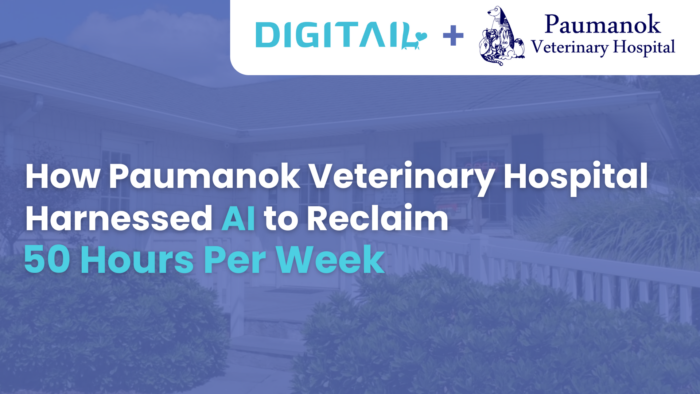
Artificial Intelligence in Veterinary Medicine: The Next Paradigm Shift
We are thrilled to share the results from our groundbreaking survey, Artificial Intelligence in Veterinary Medicine, conducted in collaboration with the American Animal Hospital Association (AAHA). This pioneering study, the first of its kind, aimed to capture the veterinary profession’s sentiments towards artificial intelligence (AI) and its burgeoning role in veterinary care. A heartfelt thank you to all the veterinary professionals who took the time to share their insights and contribute to this important conversation.
Download the Whitepaper:
The Pulse of the Veterinary Profession on AI
The survey revealed a profession at the cusp of a technological revolution, with 83.8% of respondents expressing familiarity with AI and its applications in veterinary medicine. A generally optimistic outlook towards AI, with a notable eagerness among younger veterinary professionals to explore and integrate these technologies into practice. Yet, alongside enthusiasm, there’s a palpable sense of caution, reflecting a balanced perspective on the advancements AI promises to bring.

AI in Practice Today
Currently, 39.2% of veterinary professionals are navigating the AI landscape through practical workplace applications. From imaging and radiology to voice-to-text transcription and administrative tasks, AI is gradually becoming a staple in enhancing clinic workflows. Those who have embraced AI tools report significant benefits, such as improved productivity, reduced administrative burdens, and advancements in diagnosis and treatment processes. The study found a direct correlation between the usage of AI tools in the professional setting and the level of enthusiasm toward this technology.
The overwhelming majority of respondents believe that integrating AI into clinic workflows could significantly contribute to revenue growth, employee satisfaction, and client retention, and potentially provide their hospital with a competitive advantage.

Barriers and Drivers of AI Adoption
The survey revealed that the reliability and accuracy of AI systems are the most prevalent concerns, with 70.3% of respondents highlighting them. Data security and privacy worries were also significant, flagged by 53.9% of participants. These challenges underscore the need for robust, reliable AI solutions that can win the trust of veterinary professionals. Other notable barriers included the cost of implementation, lack of training and knowledge, fear of job displacement, and regulatory or legal issues.
Despite these hurdles, the drive towards AI adoption is strong. Factors that could inspire AI adoption are the availability of case studies, training, and personal positive experiences, as well as existing integrations of AI within the software used at the practice. The potential for AI to improve client education, patient record management, and medical triage was also recognized, indicating a broad awareness of the benefits AI can bring to veterinary medicine.

The Potential of AI in Veterinary Practice
The future does look promising, with 38.7% of respondents eager to incorporate AI into their practices in the coming years. This enthusiasm is a testament to the profession’s recognition of AI’s potential to revolutionize veterinary care. With the most commonly cited benefits of AI integration, including improved productivity and time savings, reduced administrative workload, and increased efficiency in diagnosis and treatment, the majority believe that AI can significantly contribute to revenue growth, enhance employee satisfaction, improve client retention, and provide a competitive edge.

I believe in this technology’s real-world applications, so learning about its widespread use is deeply encouraging. In less than a year, veterinarians report a level of adoption similar to computer programmers. I’ve occasionally heard that veterinarians are slow to adopt new technology, but it would seem that this is not the case when the technology is pluripotent, affordable, and accessible.
Dr. William Tancredi
The insights from our survey with AAHA mark a significant milestone in understanding AI’s role and potential in veterinary medicine. As we stand on the cusp of a technological revolution, it’s clear that the journey ahead will require careful navigation, balancing the benefits of AI with the need to address its challenges. Together, we can harness the power of AI to elevate veterinary practice, enhancing patient care and even veterinarian quality of life.




